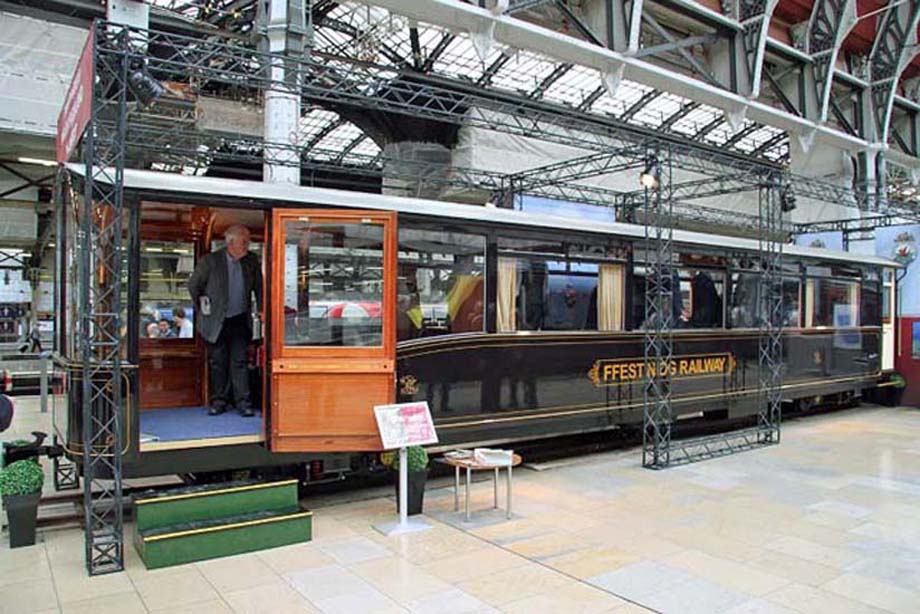The Ffestiniog & Welsh Highland Railway launched its new observation car number 150 at London's Paddington station on 12 Jun 2015.
Constructed at Boston Lodge Works, which can claim to be the oldest operating railway workshop in the world, the new vehicle is numbered to mark the 150th anniversary of the introduction of Ffestiniog Railway passenger services.
To mark this milestone in passenger carrying, the Ffestiniog set out to build its best-ever carriage.
The resulting £250,000 Pullman-style vehicle is stunning, laying down new standards for heritage railway vehicles, let alone narrow gauge.
Flying Bench to Pullman Luxury
With its location clinging to a hillside ledge along the Vale of Ffestiniog, the FR arguably recognized the potential of observation carriages from its earliest days of passenger carrying.
Those early vehicles were rudimentary affairs to say the least.
Comprising four wheels, a central longitudinal seat, a canvass roof, and little else, no wonder they are known as "Flying Benches".
The FR marked its 100th anniversary of passenger services in 1965 by creating a modern observation vehicle designed to run at the rear of the train with large end windows to give the best possible view of the scenic surroundings.
When the FR reopened the Welsh Highland Railway new Pullman carriages were built employing modern glazing systems to provide panoramic windows, WHR carriage "Glaslyn" being named by Her Majesty the Queen on 27 Apr 2010.
The effort to top that benchmark commenced by asking designers and artists to let their imaginations run free.
"There were sketches in abundance," observed FR General Manager, Paul Lewin.
"Ideas flowed with work on shapes and curves, thoughts about textures, patterns, innovative materials, and all the opportunities that new technologies can bring."
Celtic Deco
The sweeping curve on the waistline of the carriage as it drops towards the curved end window was created as a principal feature of the body by Dan Jones, a student from Huddersfield University who brought his CAD skills to bear on the project as part of a summer placement.
The interior design concept was developed by Robert Chambers, an architect working on designs for the planned new WHR station at Caernarfon.
Boston Lodge craftsmen, under the leadership of Carriage Works Manager, Norman Bond, then worked out how the modern design could be created using traditional hand crafting methods.
Glasgow's Inspiration
Unlikely inspiration arose in the form of a 100-year-old Glasgow Tram Car in Boston Lodge workshops for restoration.
Its interior featured bird's eye maple, a light wood, with beautiful natural patterns.
A veneer of this wood was used for the centre panel of number 150's roof, contrasting delightfully with the striped sapele timber along the sides and below the waist.
No standard seat from another vehicle was suitable for this carriage.
Instead, hours of design work was put into creating specially hand-crafted seats, the curves of which are designed to match the tables and interior.
Technology also played its part with the carriage featuring an on-board Wi-Fi information point, double glazing, shaped glass, and modern heating systems, all built on the foundation of a strong steel underframe.
"We think that by looking back into the past, we have come up with a design for the future, combining style with a relaxed ambiance, a hint of times past, but very much contemporary," commented Paul Lewin.
In fact the classic Art Deco theme reflected in a contemporary Welsh design has rapidly been dubbed "Celtic Deco" by the Ffestiniog.
Launch Presentations
The 12 Jun 2015 launch was visited by Sir Peter Hendy CBE, Commissioner of Transport for London, who presented F&WHR General Manager Paul Lewin and Chairman Dr. John Prideaux with a Ffestiniog Railway London Transport roundel.
In exchange he was given a replica of one of the hand-carved wooden dragons that adorn the interior of the new carriage.
Following its 8-27 Jun 2015 display on Paddington's platforms 8 and 9 beside the Isambard Kingdom Brunel "talking statue" the carriage commences a tour to promote the F&WHR for the rest of 2015.
An appearance at the Shrewsbury Flower Show is booked with other venues to be announced.
It will enter traffic (with a new service car) in 2016, forming the second vehicle in a £750,000 investment in constructing a new seven-carriage train.
The Historic Importance of Boston Lodge
Boston Lodge, built on the site of a quarry which produced the stone from which The Cob at Porthmadog was constructed between 1808-1811, was developed to build and maintain wagons for the then new 13 mile tramway linking the slate quarries at Blaenau Ffestiniog to the wharves at Porthmadog.
This stakes its claim to being the oldest operating railway workshop in the world.
The Ffestiniog Railway introduced steam in 1863, the works taking on responsibility for locomotive maintenance, and built its first locomotive, Double-Fairlie Merddin Emrys, in 1879.
Subsequent construction includes a further three double engines, today's Single-Fairlie Taliesin, and 2-6-2T Lyd, out-shopped in 2010.
While the Ffestiniog Railway was not the first narrow gauge railway to introduce steam, it was the first railway in the world to adopt and make regular use of steam locomotives working significant distances on a public railway on a gauge as narrow as 2 feet (actually 1 foot 11 1/2 inches).
One of its first steam locos, "Princess" built by George England at Hatcham Ironworks in New Cross, London, and delivered to the FR in 1863, was displayed at Paddington in April 2013 following a cosmetic makeover.
Author unknown.
(likely no image with original article)
(usually because it's been seen before)
(the image is altered or fake)
provisions in Section 29 of the
Canadian Copyright Modernization Act.




